Tashi Lhunpo, Bylakuppé, Karnataka, India - This morning an estimated 12,000 people, monks, nuns and laypeople gathered in and around the temple at Tashi Lhunpo Monastery re-established in the Tibetan settlement of Bylakuppé, Karnataka, to pray for victims of the recent devastating earthquake in Tibet. The regions of Tibet struck most severely by the earthquake were Shigatsé and Dingri. The principal monastery in Shigatsé is Tashi Lhunpo, which, founded by the First Dalai Lama, Gyalwa Gendun Drup, was the seat of the Panchen Rinpochés.
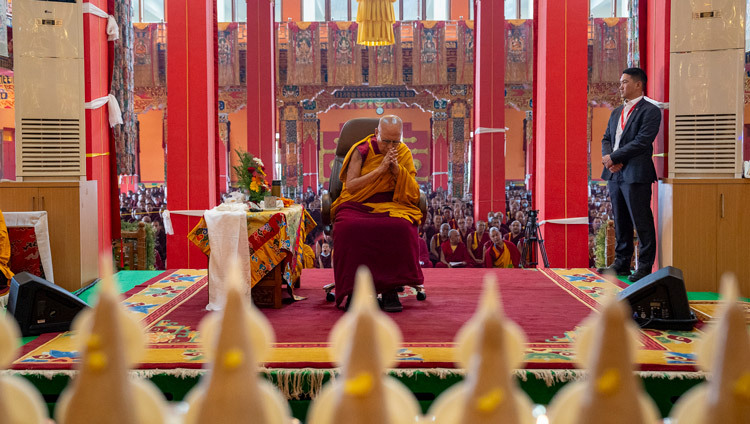
As it happens, His Holiness the Dalai Lama is presently staying at the Tashi Lhunpo Monastery re-established in South India. His joining a large assembly to pray for the people of Shigatsé and Dingri is therefore especially propitious.
Members of the public from surrounding Tibetan settlements began to arrive very early this morning, and were admitted from 6:15am. Monks sat in orderly rows in the temple. While waiting for the formal prayers to begin, the congregation chanted the mantra of Buddha Shakyamuni.
When His Holiness arrived he took his seat facing colossal gilded images of the Buddha and the First Dalai Lama, as well as prominent photographs of the previous Panchen Rinpoché and his successor, Gendun Chökyi Nyima. To His Holiness’s right sat Sharpa Chöjé Rinpoché, Abbots and former Abbots. They were joined by retired members of the Central Tibetan Administration and the Tibetan Parliament-in-Exile.
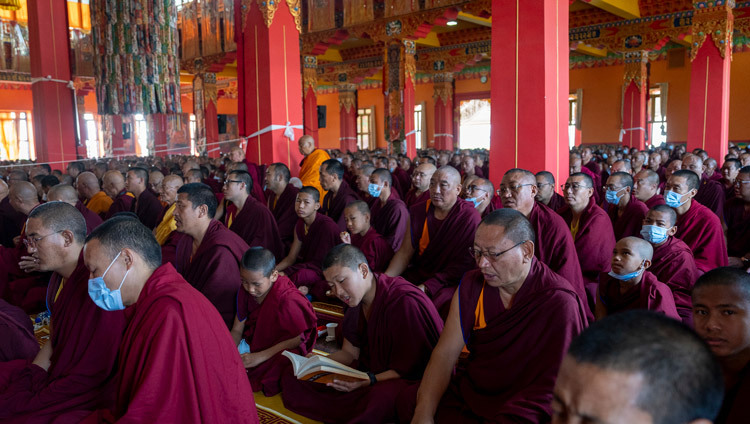
Members of the media were allowed into the temple to observe and record His Holiness’s participation in the assembly.
Prayers began with the ‘Three Continuums’, a praise and supplication to the Buddha, followed by the verse for taking refuge and generating the awakening mind of Bodhichitta. Periodically His Holiness turned to survey the gathering of monks and catch their eye.
Prayers continued with the ‘Prayer of the Four Immeasurable Wishes’ and the ‘Samantabhadra Prayer—the King of Prayers’. Tibetan butter tea and bread were distributed and offering prayers were said to bless them.
The Tashi Lhunpo Disciplinarian announced the recitation of prayers led by His Holiness and other spiritual masters. He then read out a list of donations that had been made to support the gathering.
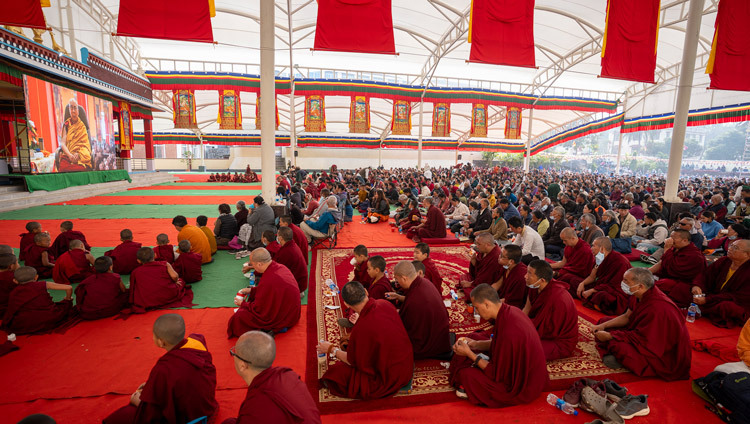
Following a verse of salutation from Nagarjuna’s ‘Fundamental Wisdom’,
‘In dependent arising
there is no ceasing, no arising,
no annihilation, no permanence,
no coming, no going,
no separateness and no sameness,
I prostrate to the consummate Buddha,
the supreme among all teachers,
the one who taught [this] peace,
which is free of elaborations,’
came a recitation of Jé Tsongkhapa’s ‘Praise to the Buddha for Teaching Dependent Arising’.
After chanting the 7th Dalai Lama, Gyalwa Kalsang Gyatso’s ‘Praise to Avalokiteshvara’, the entire assembly recited Avalokiteshvara’s mantra—Om mani padmé hung—for everyone affected by the earthquake. The session concluded with the ‘Prayer of True Words Invoking the Three Jewels’.
Before leaving the temple, His Holiness addressed the assembly as follows:
“Recently, a disastrous earthquake struck Tibet, causing casualties and widespread devastation. This was due to karma. People with no faith in the Dharma have no recourse than to be overwhelmed by grief. However, those of us who have faith in the Buddha Dharma can view experiences such as these as opportunities to purify negative karma created in the past and to cultivate positive thoughts for the future. In this way we can transform adversity into something positive. Disasters such as this can help us strengthen our resolve to engage diligently in generating the awakening mind of bodhichitta and an understanding of the view of emptiness.
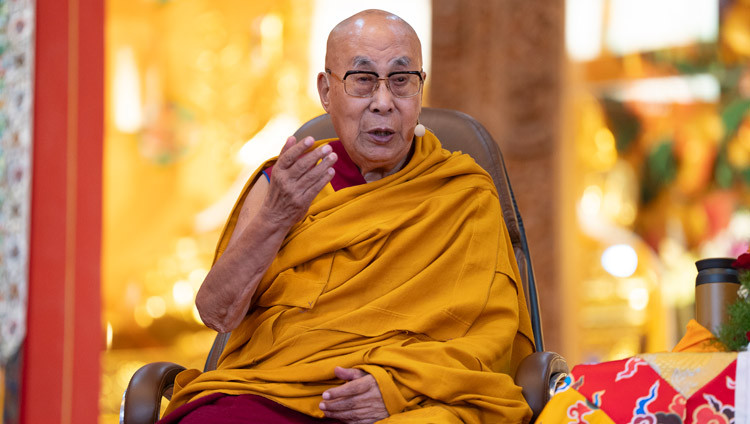
“When faced with disasters such as this earthquake in Tibet, we can transform the way we think about it into factors on the path to enlightenment. The ability to do this is totally in our hands. Although negative karma has ripened, we can take it as an opportunity to strengthen our determination.
In my own case, seeing reports of the devastation the earthquake had brought strengthened my determination to cultivate bodhichitta, the view of emptiness and to make fervent supplications to Avalokiteshvara. Instead of losing heart and weeping in distress, transforming adversity into a factor on the path to enlightenment is an opportunity we practitioners can seize upon. Although many natural calamities are taking place in Tibet, we should be able to transform these misfortunes into factors on the path to enlightenment and pray that as a result we may actually make progress on the path. Survivors also should not lose heart but generate renewed determination.
“Tibet is unquestionably the land of the followers of Avalokiteshvara. Therefore, we should continuously and diligently cultivate positive thoughts. Seeing reports of the destruction that has taken place, the fruition of irreversible karma, has been really saddening. However, it would be helpful if we could view this tragedy as an opportunity to cultivate a genuine aspiration for enlightenment. This is how we can please Avalokiteshvara.
“We should not be disheartened. Earthquakes are natural calamities; we cannot blame anyone else for them. They are natural phenomena, not the result of human activities. Seen in this way, there is no reason to be angry with the Chinese. Since what has happened is a result of karma, Tibetans all over the world, those in Tibet and elsewhere, should work on cultivating positive thoughts.
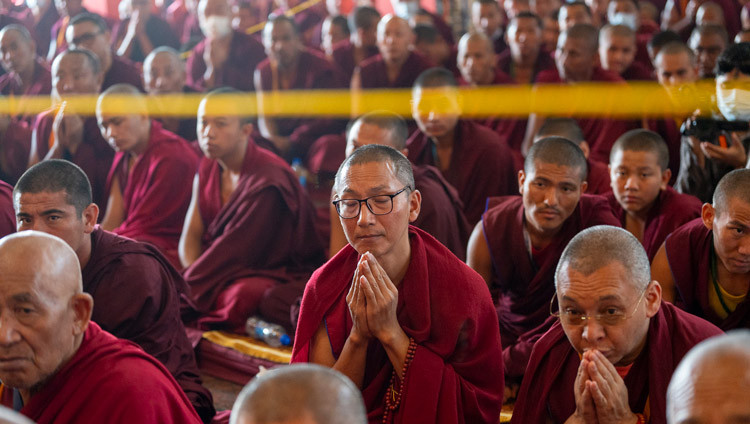
“As far as China is concerned, it appears that the number of Chinese Buddhists is growing and increasing numbers of them respond to my name in a positive way.
“As I said earlier, we should not allow ourselves to become disheartened but work hard to cultivate positive thoughts we have not cultivated before, and to enhance those positive thoughts we have already cultivated. It is important to maintain the bonds between us that are founded on our unshakable faith and commitment.
“On my part, I have been really determined in the way I’ve lived my life, and I will continue to be determined until I am more than one hundred years old. We should all be resilient and diligently cultivate bodhichitta and the view of emptiness on a daily basis. This is an offering that will truly please the Buddhas. This is the best way to cultivate merit for this life and the life hereafter. We can also set an example to others of how to reduce thoughts of anger and attachment and bring about peace within ourselves.
“Generally, people around the world admire Tibetans. They appreciate our warm nature, and value the Tibetan way of life. I have many friends who respect Tibetans for their good manners.
“As I’ve already told you, I am determined to do my best. And if signs in my dreams and other indications are taken into account, I may live to be more than 110. I will do my best, and all of you, my Dharma friends, should do your best too. This tragedy that has taken place in Tibet should be neither a cause for anger nor something that makes us disheartened. By understanding how to transform hardship into factors on the path to enlightenment, we should be able to transform how we think of this disaster into an opportunity for hope.”












